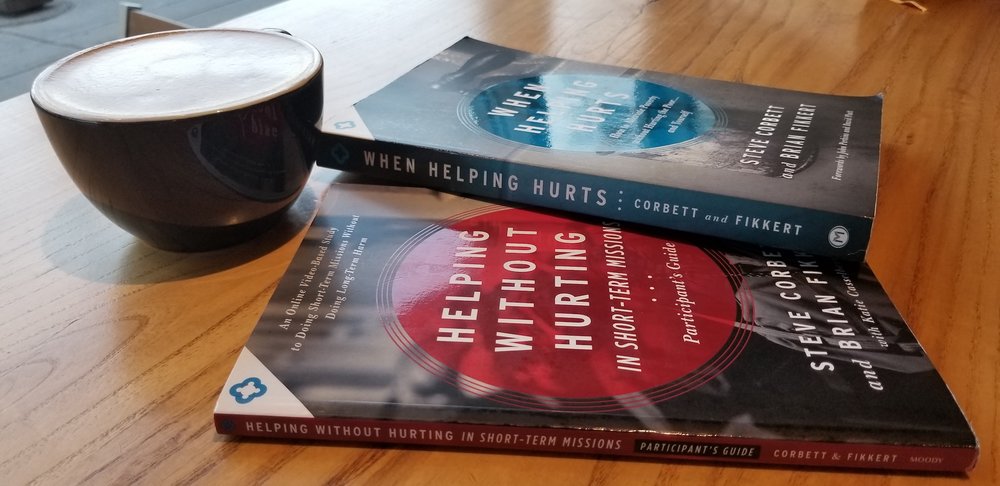Here we are, at The Reflecting Pool, a place where we can consider how best to serve others through reflections, learning, questions, and dialogue! Occasionally, we’ll dive-in to step away from traditional Lovelight Stories and reflect upon what we’re learning, how we’re helping others, and what other content you’d like to see. I’ve been working with nonprofits since last spring and this is already my eleventh story, so I feel like it’s time to take another dip in the pool. 😊

When I set out on this journey to work with the vulnerable, I didn’t know what to expect other than that the journey would be more than I could ever expect! Soon after I started preparing for a mission trip to Haiti, I was exposed to a different way of looking at poverty alleviation. I was forced to think about what’s actually working and what isn’t. All of a sudden my perspective shifted. My eyes opened. My lens cleared of fog I didn’t know was there - and I want to share some of that with you!
So, let’s put on our glasses - that fog is about to clear!
Three Stages:
First, poverty alleviation can be broken into three stages: relief, rehabilitation and development.
-
Relief happens immediately following an emergency. It involves life-saving action and alleviation of suffering. In the most accurate sense, this is “aid”.
-
Rehabilitation follows soon after. It helps restore livelihoods to a preexisting state, while also enabling communities to better respond to future crises.
-
Development is a slow, long-term process and seeks to improve the standard of living over many years or decades.
Ways we get it wrong:
Here’s a few ways (as I’ve learned) that we get poverty alleviation wrong:
-
We often confuse relief with development work. When we dump a bunch of clothes or bags of rice on a struggling country that is long past the relief phase after a crisis, we further their struggle by putting out of business those who sell clothes or farm rice for a living. Who wants to pay for rice when they can get it for free?
-
To further this concept, when bags of rice are continually dumped or other free resources flood in, people are conditioned to wait for the next bag of rice or free resource instead of trying to change their situation. They become entitled. We disempower them and strip them of their dignity.
-
Those of us from the western world tend to look at those in the majority world as needing us to save them from their poverty - that we know what they need and can solve their problems. When in reality, they have unique insights and understand their own cultural contexts and circumstances better than we do. We might think they need emergency food, when they really need access to education instead, so we provide the food and further perpetuate the cycle of needing food.
-
Worse yet, we sometimes tend to believe that if we are providing something to them, they should just be grateful to have our assistance. In a sense, we are placing ourselves as being superior and looking down on those we want to help. Sadly again, stripping them of their dignity.
“When we do for those in need what they have the capacity to do for themselves, we disempower them.” - Toxic Charity
According to the Chalmers center, about $1.6 billion is spent on international short-term mission travel per year. During those trips, we often go to “Do”. We paint schools, bring donated goods, fix a road - which are all nice things, but us “doing” or “giving” things doesn’t help those in need pull themselves out of poverty. Instead, it perpetuates the cycle of dependency and other issues as listed above. Think what we could do with an extra $1.6 billion funneled into healthy giving!
Knowing all this, why in the world did I go to Haiti when that trip money could be donated to the cause instead? I went, because helpful work can be done in a week and short-term mission teams are needed to support the people we’re seeking to help. But it’s much different than one might think…or at least different than what I once thought.
Affirming Dignity:
Now, let’s put on those sun glasses to see the bright side of poverty alleviation when it’s done in a way that affirms dignity!
-
First, in order to truly help the poor, we need to realize we all have poverty on some level. Where they may lack material resources, we lack in another area spiritually, emotionally, physically - the list goes on! We are all people with blessings, as well as difficulties. When we truly believe they are poor and we are poor, we can engage with them in humility and open our hearts to learn from the very people we are trying to help.
-
The best thing we can do is engage, listen, and let those who are on the ground lead. No one knows what they really need better than themselves.
-
In the same sense we can walk with them by doing with them, not doing for them. This can be a tough one, especially on a mission trip. Our natural desire is to complete projects for them or bring goods to give away. It’s important we realize the best thing we can do is to be with them, even if our own to-do list checking brains want to quickly finish a tangible project by the end of the day.
-
Use an asset-based approach, rather than need-based. Ask, what is right with you? What gifts do you have? How can the individuals and organizations in your community work together to improve your community? This approach affirms their dignity and allows us to see them in ways we maybe haven’t considered yet. This approach answers the question, “How can you use your assets to address your own needs?” These are people who have many great gifts who want to address their own needs just like us. They may just need help seeing these gifts.
-
As their gifts are uncovered, take the opportunity to learn from them. Let them be the teachers. There really is much for us to learn, and doing so affirms their dignity too!
-
Take a participatory approach. Ask the poor at each step of the way, “What do you think?” Again, this affirms their dignity and helps us consider the situation through a lens only they may have.
-
Let them lead the charge, taking the initiative with our support. Let them be ultimately responsible for outcomes and change. Ensure they invest part of themselves in their own development projects, whether it be financially, through resources, or labor.
-
Let them lead the pace of their projects. In western societies, we like to get work done quickly. It’s important to step back and realize they need to lead the charge at their own pace. The real development work isn’t completing construction of a school, it’s the fact local people are taking ownership and moving their own needs forward, regardless of how slow or fast that may be. Our best roles are as catalysts, facilitators, and connectors!
“The goal is to see people restored to being what God created them to be: people who understand that they are created in the image of God with the gifts, abilities, and capacity to make decisions and to effect change in the world around them; and people who steward their lives, communities, resources, and relationships in order to bring glory to God.” - The Chalmers Center
Toxic Charity’s Oath of Compassionate Service summarizes this well:
-
Never do for the poor what they have (or could have) the capacity to do for themselves.
-
Limit one-way giving to emergency situations.
-
Strive to empower the poor through employment, lending, and investing, using grants sparingly to reinforce achievements.
-
Subordinate self-interests to the needs of those being served.
-
Listen closely to those you seek to help, especially to what is not being said - unspoken feelings may contain essential clues to effective service.
-
Above all, do no harm.
“Authentic relationships with those in need have a way of correcting the we-will-rescue-you mind-set and replacing it with mutual admiration and respect.”
All in all, “Community development’s aim is to strengthen capacity rather than focus on providing services.” (Toxic Charity) Knowing this isn’t an end all, fix all; helping the poor is complicated. It’s a long process. It’s difficult and so easy to mess up. (Really though - Read about one of my most shameful attempts to help.)
Yet, if we desire to help, we have a responsibility to educate ourselves and determine our own giving approach we believe is the most life-giving.

Resources:
Here are a few great resources to accompany all we’re learning! Much of what’s included in this post stems from these resources. 🙌 Whether approached from a Christian standpoint or an objective worldview, together, these three resources shed light on long-term poverty alleviation techniques that are working. (The authors of both books reside near Atlanta too!)
-
When Helping Hurts - This approaches poverty alleviation from a biblical perspective, while focusing heavily on tangible examples of how to help the poor without hurting them.
-
Toxic Charity - This is a quick read and focuses on similar techniques of When Helping Hurts with less emphasis on biblical worldview.
-
If you haven’t heard of the documentary called, Poverty, Inc., you’ll want to check that out too! It draws upon over 200 interviews filmed in 20 countries, showing what happens when we approach poverty alleviation incorrectly. Call me crazy, but I’ve watched it 3 times already! Here’s the movie trailer.
As we continue on this journey, my goal is to get more involved with organizations that approach poverty alleviation through this lens and, of course, continue to share what I’m learning with you! Yet, not all organizations will align with this way of thinking and I don’t believe they should. There is a time and place for different approaches. It just all comes down to whether the need is a rare crisis or chronic cycle of poverty.
Probably the most exciting news is that not only have I read about it, but I’ve seen and experienced this life-giving work take place! It’s real. We travelled with 410 Bridge to Haiti this past summer where they are facilitating true development work. Check out some of my other Haiti stories to get a glimpse of how they’re putting this work into practice, and I’ll share more in next month’s story!
Until then, consider in what ways you’ve unintentionally hurt the poor while trying to help. How could you change your approach to be more life-giving? What questions are circling in your mind?
Let’s discuss - Comment below!

I’ve already received several personal emails about this post! I’m so happy this story resonates with you! Feel free to also share your thoughts directly in the comments here too. I love to hear from you!